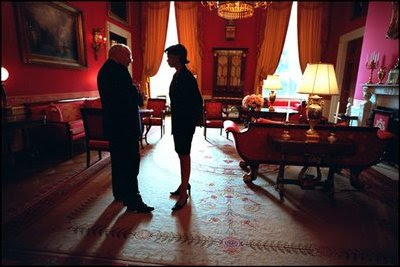The Vice President for Torture
 There is an eye opening article in yesterday's Washington Post regarding Cheney's role in implementing "robust interrogation techniques" and how he sought to distinguish this from torture, making distinctions that - to most sentient human beings - would be utterly meaningless.
There is an eye opening article in yesterday's Washington Post regarding Cheney's role in implementing "robust interrogation techniques" and how he sought to distinguish this from torture, making distinctions that - to most sentient human beings - would be utterly meaningless.
What's startling is how early on in the war on terror that Cheney is pushing for this stuff.
The events of Abu Ghraib have often been written off as the work of a few bad apples, but here we have reports that, as early as January 2002, Cheney is looking for ways to by-pass the Geneva Conventions. Now the Geneva Conventions not only bans torture, but in equally unequivocal terms also bans the use of "violence," "cruel treatment" or "humiliating and degrading treatment" against a detainee "at any time and in any place whatsoever."Shortly after the first accused terrorists reached the U.S. naval prison at Guantanamo Bay, Cuba, on Jan. 11, 2002, a delegation from CIA headquarters arrived in the Situation Room. The agency presented a delicate problem to White House counsel Alberto R. Gonzales, a man with next to no experience on the subject. Vice President Cheney's lawyer, who had a great deal of experience, sat nearby.
The meeting marked "the first time that the issue of interrogations comes up" among top-ranking White House officials, recalled John C. Yoo, who represented the Justice Department. "The CIA guys said, 'We're going to have some real difficulties getting actionable intelligence from detainees'" if interrogators confined themselves to treatment allowed by the Geneva Conventions.
From that moment, well before previous accounts have suggested, Cheney turned his attention to the practical business of crushing a captive's will to resist. The vice president's office played a central role in shattering limits on coercion of prisoners in U.S. custody, commissioning and defending legal opinions that the Bush administration has since portrayed as the initiatives, months later, of lower-ranking officials.
Indeed, The War Crimes Act of 1996 makes any grave breaches of those restrictions a US Felony. So how did Cheney get around the fact that what he was proposing was actually a felony under US law?
The vice president's counsel proposed that President Bush issue a carefully ambiguous directive. Detainees would be treated "humanely and, to the extent appropriate and consistent with military necessity, in a manner consistent with the principles of" the Geneva Conventions. When Bush issued his public decision two weeks later, on Feb. 7, 2002, he adopted Addington's formula -- with all its room for maneuver -- verbatim.Okay, so Cheney has now managed - as regards to compliance with US law - to buy himself wriggle room. He is now no longer bound by the letter of the Geneva Conventions, he is now acting "in a manner consistent with the principles of" the Geneva Conventions only as much as this is "consistent with military necessity".
That's quite a lot of wriggle room. According to Alberto J. Mora, Cheney was actually setting out, when he asked Bush to adopt Addington's formula, to specifically avoid a ban on cruelty. Now, most sane people would at this point be perplexed, after all what is the difference between torture and cruelty? Mora has the answer:
In international law, Mora said, cruelty is defined as "the imposition of severe physical or mental pain or suffering." He added: "Torture is an extreme version of cruelty."What fucking planet are these people on? It is simply astounding that there are people sitting around in offices in Washington making definitions of what constitutes an extreme version of cruelty. However, according to the article, that is precisely what they were doing. And what distinction did they come up with?
The Justice Department delivered a classified opinion on Aug. 1, 2002, stating that the U.S. law against torture "prohibits only the worst forms of cruel, inhuman or degrading treatment" and therefore permits many others. [Read the opinion] Distributed under the signature of Assistant Attorney General Jay S. Bybee, the opinion also narrowed the definition of "torture" to mean only suffering "equivalent in intensity" to the pain of "organ failure ..... or even death."So, any pain inflicted upon a captive that is not equivalent in intensity to the pain of organ failure or even death is not torture, it is merely being cruel. With such a standard in place, US pronouncements that "we don't do torture" are utterly meaningless. Indeed, the very fact that they seek to make such distinctions would lead any reasonable person to assume that they are, indeed, engaging in torture; they have simply decided to call it cruelty.
Now this "torture memo" as it became known has always been attributed to Yoo, a law professor at the University of California at Berkeley who had come to serve in the Office of Legal Counsel. However, Yoo now says that Gonzales and deputy White House counsel Timothy E. Flanigan also contributed to the analysis.
So now the line has moved from making a false distinction between cruelty and torture towards advocacy of torture itself. And the only argument at this point is regarding who should be allowed carry out these "robust interrogation techniques".The vice president's lawyer advocated what was considered the memo's most radical claim: that the president may authorize any interrogation method, even if it crosses the line into torture. U.S. and treaty laws forbidding any person to "commit torture," that passage stated, "do not apply" to the commander in chief, because Congress "may no more regulate the President's ability to detain and interrogate enemy combatants than it may regulate his ability to direct troop movements on the battlefield."
That same day, Aug. 1, 2002, Yoo signed off on a second secret opinion, the contents of which have never been made public. According to a source with direct knowledge, that opinion approved as lawful a long list of interrogation techniques proposed by the CIA -- including waterboarding, a form of near-drowning that the U.S. government has prosecuted as a war crime since at least 1901. The opinion drew the line against one request: threatening to bury a prisoner alive.
Yoo said for the first time in an interview that he verbally warned lawyers for the president, Cheney and Defense Secretary Donald H. Rumsfeld that it would be a risky policy to permit military interrogators to use the harshest techniques, because the armed services, vastly larger than the CIA, could overuse the tools or exceed the limits. "I always thought that only the CIA should do this, but people at the White House and at DOD felt differently," Yoo said. The migration of those techniques from the CIA to the military, and from Guantanamo Bay to Abu Ghraib, aroused worldwide condemnation when abuse by U.S. troops was exposed.Is there anyone left on the planet who can read this and still believe that what took place in Abu Ghraib was the work of a few bad apples? According to this recent interview with Yoo, he has just admitted for the first time that this was being discussed with lawyers for the President, the Vice President and the Defense Secretary. I mean there is simply nowhere higher in the chain for this to go. And, as we know that these techniques were exported to Abu Ghraib, and that this was discussed with lawyers representing the top tiers of the administration, one can only assume that this was exported with their permission.
There are many more fascinating things in the article, which you can read by clicking the title, but it does seem to make a very strong case that not only were the US engaging in torture, whilst choosing to euphemistically refer to it as "cruelty", but they were doing so with the complete knowledge and complicity of the President, the Vice President and the then Secretary of Defense.























No comments:
Post a Comment